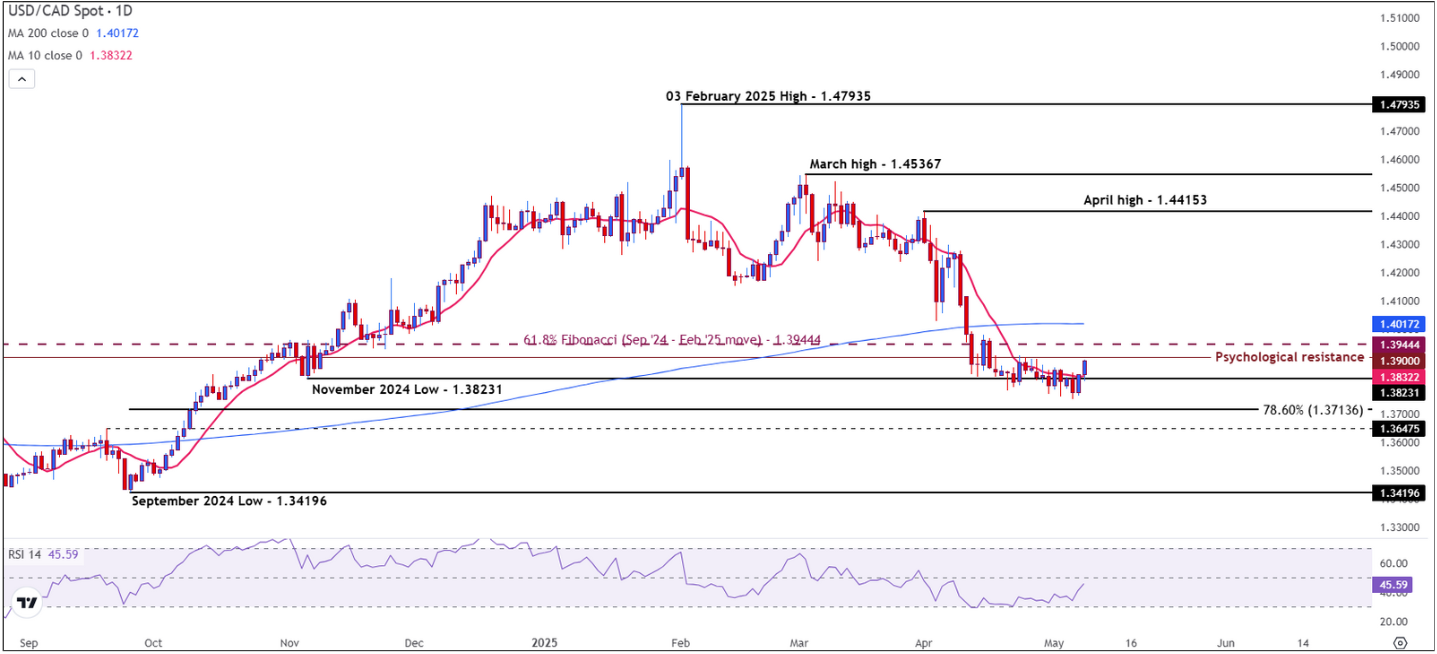- The USD/CAD is approaching 1,3900 while the Canadian dollar weakens before key risk events.
- Tariff tensions between the US and Canada persist, with markets attentive to trade -related signals.
- The pair of the Canadian dollar advances, waiting for the Risk Review of the BOC and the announcement of the commercial agreement between the US and the United Kingdom by Trump.
The Canadian dollar (CAD) is weakening against the US dollar (USD) on Thursday while investors prepare for a crucial day of policy and trade holders that could redefine the feeling of the North American market.
At the time of writing, the USD/CAD is quoted at 1,3880, with an increase of 0.34% in the day, with the pair of strengthening as the markets expect the review of the Financial System (FSR) of the Bank of Canada (BOC) and a speech of the president of the USA, Donald Trump, who is expected to reveal a new commercial agreement between the United Kingdom and the US 14:00 GMT.
Risk review of the Canada Bank at the Center for Care while markets evaluate financial vulnerabilities
The review of the BOC financial system, published twice a year, offers a detailed evaluation of systemic vulnerabilities within Canada’s financial infrastructure.
Although it is not a monetary policy document, the FSR is relevant to market participants by shedding light on the risks of financial stability, including household debt, credit conditions and real estate market exposure, which could influence future guidelines for regulatory fees or responses. With the economy of Canada facing slow growth and moderate inflation, any indication of a hardening of financial conditions or exposure to external risks could weigh on the Canadian dollar.
The governor of the BOC, Tiff Macklem, will hold a press conference to discuss the content of the FSR findings after publication, with the markets closely observing its tone in search of relevant signals for politics.
Commercial Agreement between the US and the United Kingdom and Carney meeting transfer the focus to the North American Commercial Policy
Simultaneously, President Trump is expected to announce the completion of a new commercial agreement between the US and the United Kingdom, the first after the “Day of Liberation.”
The markets are attentive to the terms of this agreement for its broader implications, particularly if it establishes a precedent for bilateral arrangements that avoid traditional multilateral frameworks.
The agreement could also open the door to secondary commercial alignments that benefit currencies linked to raw materials, such as the Canadian dollar, especially if it improves transatlantic logistics and the demand for American intermediate goods.
The two policy developments follow greater political friction earlier this week after the Canadian Prime Minister Mark Carney, met with President Trump in the Oval office on Tuesday. Although the meeting was described as “cordial but firm”, Carney dismissed Trump’s comments that Canada could “become the 51st state,” stating: “Canada is not for sale, it will never be for sale.”
Despite the tension, the two leaders discussed the future of the United States-Mexico-Canada (USMCA) and commercial terms that affect the US supply chain. Trump reiterated that the breach of the USMCA provisions “will not remain unanswered,” suggesting possible specific tariff reviews per sector.
The USD/CAD is recovered from the side bias support before key catalysts
The USD/CAD advances Thursday, recovering above the simple mobile average (SMA) of 10 days, currently in 1,3832. At the same time, the widest structure for the PAR is still limited below a key psychological resistance zone in 1,3900 –1.3944. This resistance band includes a round level and fibonacci setback from 61.8% of September from September to February and has limited upward breaks throughout May.
USD/CAD DAILY GRAPH

The pair remains above the minimum of November in 1,3823, which has provided a firm support in recent days. A daily closure below this level would exhibit a deeper support in the fibonacci setback of 78.6% about 1,3713.
On the positive side, a sustained fortress above 1,3944 could trigger a renewed purchase pressure towards the 200 -day mobile average in 1,4017, with a break that could pave the road to the maximum of April in 1,4415.
The Relative Force Index (RSI) has risen to 45.59 in the daily chart, indicating a fading of the bearish impulse but lacking a clear directional bias as it approaches the midline in 50.
Canadian dollar faqs
The key factors that determine the contribution of the Canadian dollar (CAD) are the level of interest rates set by the Bank of Canada (BOC), the price of oil, the main export product of Canada, the health of its economy, inflation and commercial balance, which is the difference between the value of Canadian exports and that of its imports. Other factors are market confidence, that is, if investors bet on riskier assets (Risk-on) or seek safe assets (Risk-Off), being the positive risk-on CAD. As its largest commercial partner, the health of the US economy is also a key factor that influences the Canadian dollar.
The Canada Bank (BOC) exerts a significant influence on the Canadian dollar by setting the level of interest rates that banks can provide with each other. This influences the level of interest rates for everyone. The main objective of the BOC is to maintain inflation between 1% and 3% by adjusting interest rates to the loss. Relatively high interest rates are usually positive for CAD. The Bank of Canada can also use quantitative relaxation and hardening to influence credit conditions, being the first refusal for CAD and the second positive for CAD.
The price of oil is a key factor that influences the value of the Canadian dollar. Oil is the largest export in Canada, so the price of oil tends to have an immediate impact on the value of the CAD. Generally, if the price of oil rises, the CAD also rises, since the aggregate demand of the currency increases. The opposite occurs if the price of oil drops. The highest prices of oil also tend to give rise to a greater probability of a positive commercial balance, which also supports the CAD.
Although traditionally it has always been considered that inflation is a negative factor for a currency, since it reduces the value of money, the opposite has actually happened in modern times, with the relaxation of cross -border capital controls. Higher inflation usually leads to central banks to raise interest rates, which attracts more capital of world investors who are looking for a lucrative place to save their money. This increases the demand for the local currency, which in the case of Canada is the Canadian dollar.
The published macroeconomic data measure the health of the economy and can have an impact on the Canadian dollar. Indicators such as GDP, manufacturing and services PMIs, employment and consumer confidence surveys can influence the CAD direction. A strong economy is good for the Canadian dollar. Not only attracts more foreign investment, but it can encourage the Bank of Canada to raise interest rates, which translates into a stronger currency. However, if the economic data is weak, the CAD is likely to fall.
Source: Fx Street
I am Joshua Winder, a senior-level journalist and editor at World Stock Market. I specialize in covering news related to the stock market and economic trends. With more than 8 years of experience in this field, I have become an expert in financial reporting.







